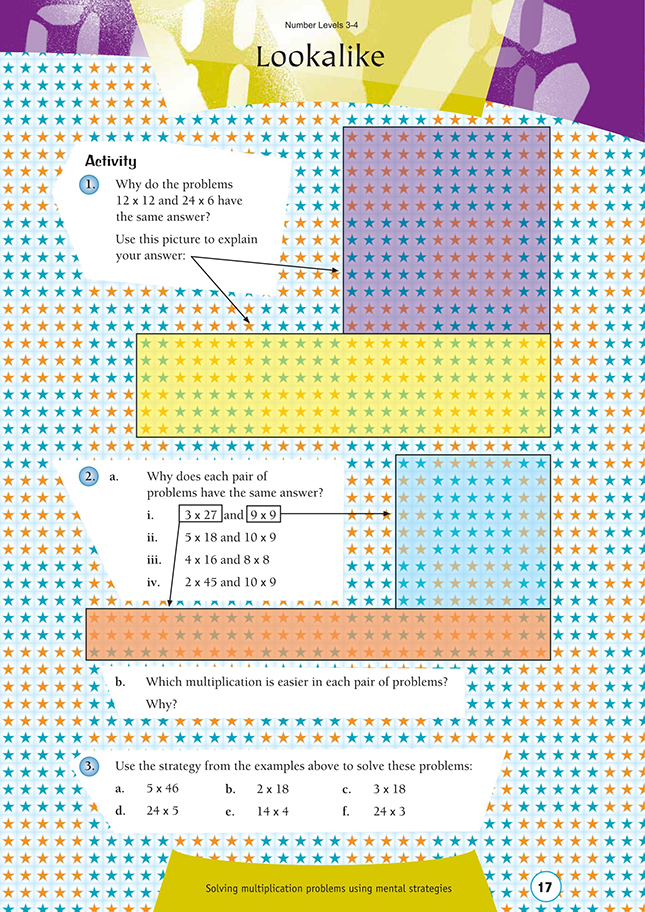This is a level 4 number activity from the Figure It Out series. It relates to Stage 7 of the Number Framework.
A PDF of the student activity is included.
Click on the image to enlarge it. Click again to close. Download PDF (4.4 MB)
use "doubles and halves" strategy to solve multiplication problems
FIO, Level 3-4, Number, Book 1, Lookalike, page 17
Here is another strategy that students can use to multiply a two-digit number by a one-digit number. As in the activities on pages 15 and 16 of the students’ book, this strategy helps to develop students’ number sense.
This strategy uses a physical model. When the students compare the representation of 24 x 6 and the representation of 12 x 12, they should see that the 24 x 6 model is half as wide but twice as long as the 12 x 12 model. The students could use a hundreds field to explore various ways of rearranging models of multiplication problems. Emphasise that they are trying to rearrange the model so that it represents a known multiplication fact. For example, they could rearrange the 24 x 6 model into an 18 x 8 model, but this is not a known multiplication fact.
When the students have become familiar with rearranging the models on a hundreds field, you could discuss ways of using this strategy without working on a hundreds field. In the above problem, for example, they may notice that they have halved the larger factor (24) and doubled the smaller factor (6). In question 2a i, they divide the larger factor (27) by 3 and multiply the smaller factor (3) by 3. If they perform one operation on one of the factors, they must perform the opposite operation on the other factor, and the answer remains the same (because the opposite of division is
multiplication).
Other students may approach the problem by renaming the large factor as two small factors and then combining the factors so that the problem becomes a known multiplication fact. For example, in question 1, 24 x 6 can be renamed as 12 x 2 x 6, which can again be renamed as 12 x 12. This is possible because the order in which you multiply numbers does not matter.
Once again, encourage the students to solve these problems mentally rather than using a written form. In particular, they should not resort to using the vertical form. Students who are very competent at using the vertical form may prefer to use it, but as they solve more problems using this alternative method, they should begin to recognise that it is more efficient than writing out the problem in vertical form.
Answers to Activity
1. A 24 x 6 block is twice as long but half as wide as a 12 x 12 block. That is,
24 x 6 = 12 x 2 x 6 = 12 x 12.
2. a. i. 3 x 27 is three times as long as 9 x 9 but 1/3 as wide.
ii. 5 x 18 is half as long and twice as wide as 10 x 9.
iii. 4 x 16 is half as long and twice as wide as 8 x 8.
iv. 2 x 45 is 1/5 as long and five times as wide as 10 x 9.
b. The second statement in each pair is easier to solve because multiplying by 10 or a
single digit is easier than multiplying by numbers greater than 10.
3. Possible equations include:
a. 10 x 23 = 230
b. 4 x 9 = 36
c. 6 x 9 = 54
d. 12 x 10 = 120
e. 7 x 8 = 56
f. 12 x 6 = 72
